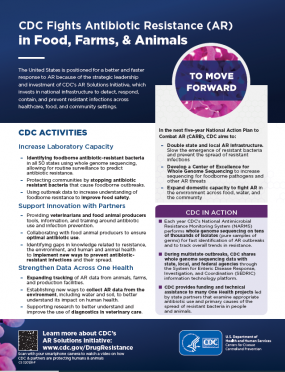Action to Fight Antimicrobial Resistance in the Food Supply
Animals, like people, carry germs in their gut, including antimicrobial-resistant germs. The American food supply is among the safest in the world, but people can still get sick from foodborne infections or from having contact with food animals. These infections can be caused by antimicrobial-resistant germs. CDC is working to detect, respond, contain, and prevent resistant foodborne infections to protect people and save lives. Learn more about how resistance can spread in the food supply.
CDC implements activities outlined in the U.S. National Action Plan for Combating Antibiotic-Resistant Bacteria, released in 2015 and 2020. These activities are funded through CDC antimicrobial resistance investments, collectively known as CDC’s Antimicrobial Resistance (AR) Solutions Initiative. Through these investments, CDC is transforming how the nation combats antimicrobial resistance.
CDC Activities
Increasing Laboratory Capacity
- Identifying foodborne antimicrobial-resistant bacteria, including Salmonella and Campylobacter, in all 50 states using whole genome sequencing, allowing for routine surveillance to predict antimicrobial resistance
- Protecting communities by stopping antimicrobial-resistant bacteria that cause foodborne outbreaks
- Using outbreak data to increase understanding of foodborne resistant germs to improve food safety
Supporting Innovation with Partners
- Providing veterinarians and food animal producers tools, information, and training to improve antibiotic and antifungal use and infection prevention
- Collaborating with food animal producers to ensure optimal antibiotic and antifungal use
- Identifying gaps in knowledge related to resistance, the environment, and human and animal health to implement new ways to prevent antimicrobial-resistant infections and their spread
Strengthening Data Across One Health
- Expanded tracking of antimicrobial resistance data from animals, farms, and production facilities
- Establishing new ways to collect antimicrobial resistance data from the environment, including water and soil, to better understand its impact on human health
- Supporting research to better understand and improve the use of diagnostics in veterinary care
Additional Work in Progress
- Doubling state and local antimicrobial resistance infrastructure to advance work across the United States
- Slowing the emergence of antimicrobial resistance and prevent the spread of resistant germs
- Expanding domestic capacity to fight antimicrobial resistance in the environment across the food supply chain
Examples of CDC Activities in Action
- Each year, CDC’s National Antimicrobial Resistance Monitoring System (NARMS) performs whole genome sequencing on tens of thousands of isolates (pure samples of germs) for fast identification of antimicrobial-resistant outbreaks and to track overall trends in resistance
- During multistate outbreaks, CDC shares whole genome sequencing data with state, local, and federal agencies through the System for Enteric Disease Response, Investigation, and Coordination (SEDRIC) information technology platform
- CDC provides funding and technical assistance to One Health projects led by state partners that examine antibiotic and antifungal use and primary causes of the spread of resistant germs in people and animals, such as working with partners from Ohio State University and calf producers to increase producer awareness and use of educational materials
